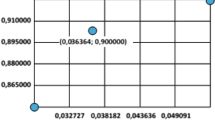Abstract
A procedure is put forward for concrete definition of constitutive relationships of the strain-hardening theory allowing for the level of damage in a material. The parameters of the equation of creep and the damage evolution relationship are assumed to be functions of stress and temperature. Efficiency of this approach is illustrated by describing creep curves for 20Kh13 and EP44 steels over a fairly wide range of stress variation.
Similar content being viewed by others
REFERENCES
Yu. N. Rabotnov, Creep of Structural Elements [in Russian], Nauka, Moscow (1966).
Yu. N. Rabotnov and S. T. Mileiko, Short-Term Creep [in Russian], Nauka, Moscow (1970).
G. S. Pisarenko, V. N. Rudenko, G. N. Tret’yachenko, and V. T. Troshchenko, Strength of Materials at High Temperatures [in Russian], Naukova Dumka, Kiev (1966).
G. S. Pisarenko (Ed.), Strength of Materials and Structural Elements under Extreme Conditions [in Russian], in 2 volumes, Naukova Dumka, Kiev (1980).
I. I. Gol’denblat, V. L. Bazhanov, and V. A. Kopnov, Long-Term Strength in Mechanical Engineering [in Russian], Mashinostroenie, Moscow (1977).
G. F. Lepin, Creep of Materials and High-Temperature Strength Criteria [in Russian], Metallurgiya, Moscow (1976).
V. P. Golub and A. D. Pogrebnyak, High-Temperature Fracture of Materials under Low-Cycle Loading [in Russian], Naukova Dumka, Kiev (1994).
A. Nadai, Theory of Flow and Fracture of Solids [Russian translation], Vol. 2, Mir, Moscow (1969).
K. J. Miller, Creep and Fracture, North Holland Publishing Company (1982).
S. A. Shesterikova (Ed.), Mechanisms of Creep and Long-Term Strength. Handbook [in Russian], Mashinostroenie, Moscow (1983).
L. Ya. Liberman and M. I. Peisikhis, Properties of Steels and Alloys Used in Boiler and Turbine Industry [in Russian], in 3 parts, Issue 16, TsKTI, Leningrad (1966).
V. T Troshchenko (Ed.), A. Ya. Krasovskii, V. V. Pokrovskii, et al., Resistance of Materials to Deformation and Fracture [in Russian], in 2 parts, Naukova Dumka, Kiev (1993).
Yu. N. Rabotnov, Theory of Creep. Mechanics in the USSR for 50 Years. In 3 parts. Part 3: Solids Mechanics [in Russian], Nauka, Moscow (1972), pp. 119–154.
S. A. Shesterikov and A. M. Lokoshchenko, “Creep and long-term strength of metals,” in: Advances in Science and Technology. Series: Solids Mechanics [in Russian], Vol. 13, VINITI, Moscow (1980), pp. 3–104.
J. Hult, “Creep in continua and structures,” in: Topics in Applied Continuum Mechanics, Springer, New York (1974), pp. 137–155.
V. P. Golub, “An experimental study of high-temperature creep, fatigue, and damage processes. Part I. Investigation techniques,” Prikl. Mekh., 37, No.4, 3–38 (2001).
V. P. Golub, “An experimental study of high-temperature creep, fatigue, and damage processes. Part II. Main mechanisms,” Prikl. Mekh., 37, No.5, 3–43 (2001).
L. M. Kachanov, “On the creep fracture time,” Izv. AN SSSR. Otd. Tekhn. Nauk, No. 8, 26–31 (1958).
V. V. Novozhilov, “On plastic loosening,” Prikl. Mekh. Matem., 29, Issue 4, 681–689 (1965).
J. Lemaitre and A. Plumtree, “Application of damage concepts to predict creep-fatigue failures,” Teoret. Osn. Inzh. Rasch., 101, No.3, 124–134 (1971).
V. I. Kovpak, Prediction of High-Temperature Strength of Metallic Materials [in Russian], Naukova Dumka, Kiev (1981).
V. P. D’yakonov, MATLAB 6/6.1/6.5+Simulink 4/5 in Mathematics and Modeling. Complete User Manual [in Russian], Solon, Moscow (2003.
V. N. Kiselevskii and B. D. Kosov, “Constitutive equations for creep in a hardenable material,” Probl. Prochn., No. 4, 8–18 (1975).
Author information
Authors and Affiliations
Additional information
__________
Translated from Problemy Prochnosti, No. 2, pp. 19 – 27, March – April, 2005.
Rights and permissions
About this article
Cite this article
Kucher, N.K. A Variant of the Strain-Hardening Theory Allowing for the Stress and Temperature Dependence of Parameters in Constitutive Equations. Strength Mater 37, 124–130 (2005). https://doi.org/10.1007/s11223-005-0025-y
Received:
Issue Date:
DOI: https://doi.org/10.1007/s11223-005-0025-y




